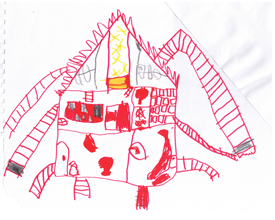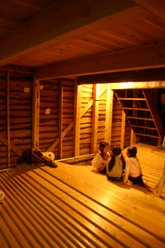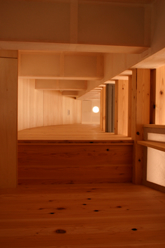HOME > Ken-no House H3 > Who is it for?

- Through children's eyes

When we think about things we often tend to forget about children. However, if we put the spotlight on children, good effects come back around to us.
To put the spotlight on children when we build a house is to focus on the house's role as a spiritual space. In a house designed in this way, the family becomes tied organically by living everyday life there.
To be tied organically, the group becomes tightly involved with each of their different kinds of human nature. Naturally, they respect each other. If the tie becomes loose the family becomes just a group of housemates, not a family. An organically tied family can form differently to the occasion of children's growth. If one of the ties is about to fall away they can change their style and respond to the problem. This allows them the opportunity to strengthen the ties. This does not mean that the family members lose their individual characters and become one colour, it means that they take notice of each other including themselves. To take notice of yourself is essential for mind growth.
To think through children's eyes is not that easy. If we stimulate them by asking questions, that is easy, but it is quite difficult for children to think about their experiences and what their dream house is like, and to express it in words is even more difficult. So, I'll introduce 2 warm-ups for child-centred house planning.
- 「Brainstorming」and the「Child in you」
First, to brainstorm with your whole family together. The theme is your "Dream House."

Brainstorming is a method to stimulate each other by introducing each other's ideas without criticism. So parents start by giving a hint to kids as an idea, the children then expand that idea and make fresh ideas and parents get stimulated by the kids' ideas. They then propose another idea. So, write down the keywords as they come out. You should never say a negative opinion. That is the only rule.
By brainstorming, parents can peep into their children's imaginative world and also children can feel that they are on the same stage as their parents and are a part of the brain of the big family project. This is very effective for completing the dream house but also afterwards it will have a good influence on the family relationship.
Second, wake the child inside yourself.

Even though everyone has had a childhood, once you become an adult you can't understand children's feelings. More or less everyone has had the experience of getting frustrated when talking logically to kids who do not accept logics. So try to remember how you experienced things when you were a child, like when you were excited, or pleased, or sad and take time to be together with those feelings.
This is the key to thinking about a child-centred house. The experience you had in your house, being hugged by parents, your relationship with your siblings, and the happenings that affected or hurt you, and try to feel those feelings. Also, remember, the place you felt comfortable, and habits and surroundings you hated which have been asleep in the corner of your mind all this time. Then, you express those memories and feelings on paper. It doesn't matter how - words, sketches, scribbles, anyhow put them down. If you have difficulty to bring back your childhood memories, try playing with kids, or read books together, or deal with kids more until you soften your brain.
- Amuse yourself "seriously"
For parents, it is mentally hard work to deal with children, so we need room in our minds for them. How do we make this room? By amusement in everyday life. Amusement is not only playing with toys but also refers to a more vague concept. When people want to achieve something they tend to cut out the excessives and keep the necessities to reach their goal in the shortest way. When you are planning a house and focus on the facilities and materials and don't think about healing or relaxing spaces, then you will find that there is no "amusement" in your house.

Life without amusement would be very dry and in that environment it is quite difficult to grow a healthy mind. The things you think are excessive, useless, uncomfortable, uneven are the places we will find amusement. People's minds need amusement. Amusement makes room in your mind. Room in your mind enriches everyday life.
We are stuck in a bad current.
Do you think that there is anything you can do for your mind in everyday life?
- Your mind won't heal. It won't grow. Its losing its flexibility and getting dull.
- You tend to rely on things which give you quick stimulation like TV, video games, etc.
- They might make you feel like you covered the hole in your mind but they won't heal your mind.
- There is a gap in your mind that has arisen without your realising it.
A few years, decades later, the gap changes shape and appears before us.

Creating amusement is not making a swing or jungle gym in the house. Kids get bored easily with things they are given. Kids are excited by things that adults think are risky, dangerous or dark. Children know that straight lines and flat places don't exist in the natural world. To make amusement and joy in everyday life is easy for children. In that ability, adults do not even compare.
Amusement creates a good current.
When the house has an amusement space, the mind loosens and the parents give children more freedom.
- Children create joy.
- Parents feel happy and the house becomes full of life energy.
- Seeing their parents like that, the children become happier and more free.
- Then, children create new joy.
When the mind is satisfied in everyday life it can be strong and considerate.
Even so, people demand convenience and comfort.
For what?
For whom?
To think about "child and parents", "family and house", and "human and space" is to grow the light seed to brighten our society.



